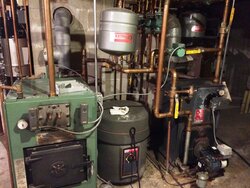Howdy folks, this is my first post here. Great site, I've been reading a lot of the stuff on here for a couple of months. WOW there is a ton of good information.
I live in New Hampshire and grew up with a wood boiler and used oil for backup and for DHW in the summer months. There was some thermal storage, I'm guessing 150-200 gallons or so, but it changed every so often because my dad was in the "business" so the boiler room saw quite a bit of action over the years. This was early '80's into the '90's and I think he was a Kerr dealer for a while. I remember the logo on the hats. Good times.
I recently moved into a house with a New Yorker WC-90 "add-on" boiler. I had never heard of this add-on boiler concept, and the previous owner wasn't much help either. Judging by the condition of the wood boiler, she barely used it, although she was kind enough to leave behind a few hundred pounds of coal in the bulkhead. I brought a couple of cords of dry wood from my old house, enough to test things this winter (which has been extremely mild so far). My questions so far:
Kirk
I live in New Hampshire and grew up with a wood boiler and used oil for backup and for DHW in the summer months. There was some thermal storage, I'm guessing 150-200 gallons or so, but it changed every so often because my dad was in the "business" so the boiler room saw quite a bit of action over the years. This was early '80's into the '90's and I think he was a Kerr dealer for a while. I remember the logo on the hats. Good times.
I recently moved into a house with a New Yorker WC-90 "add-on" boiler. I had never heard of this add-on boiler concept, and the previous owner wasn't much help either. Judging by the condition of the wood boiler, she barely used it, although she was kind enough to leave behind a few hundred pounds of coal in the bulkhead. I brought a couple of cords of dry wood from my old house, enough to test things this winter (which has been extremely mild so far). My questions so far:
- the main aquastat on the wood side was set to 150°F; the WC-90 manual says it should be 190°F. I moved it up to the recommended setting, is this the "best" spot for it?
- when I'm burning wood, can I shut off the oil burner and still get hot water where I need it?
- if I'm not going to burn wood for a few days, should I close the ball valves between the two boilers?
Kirk


